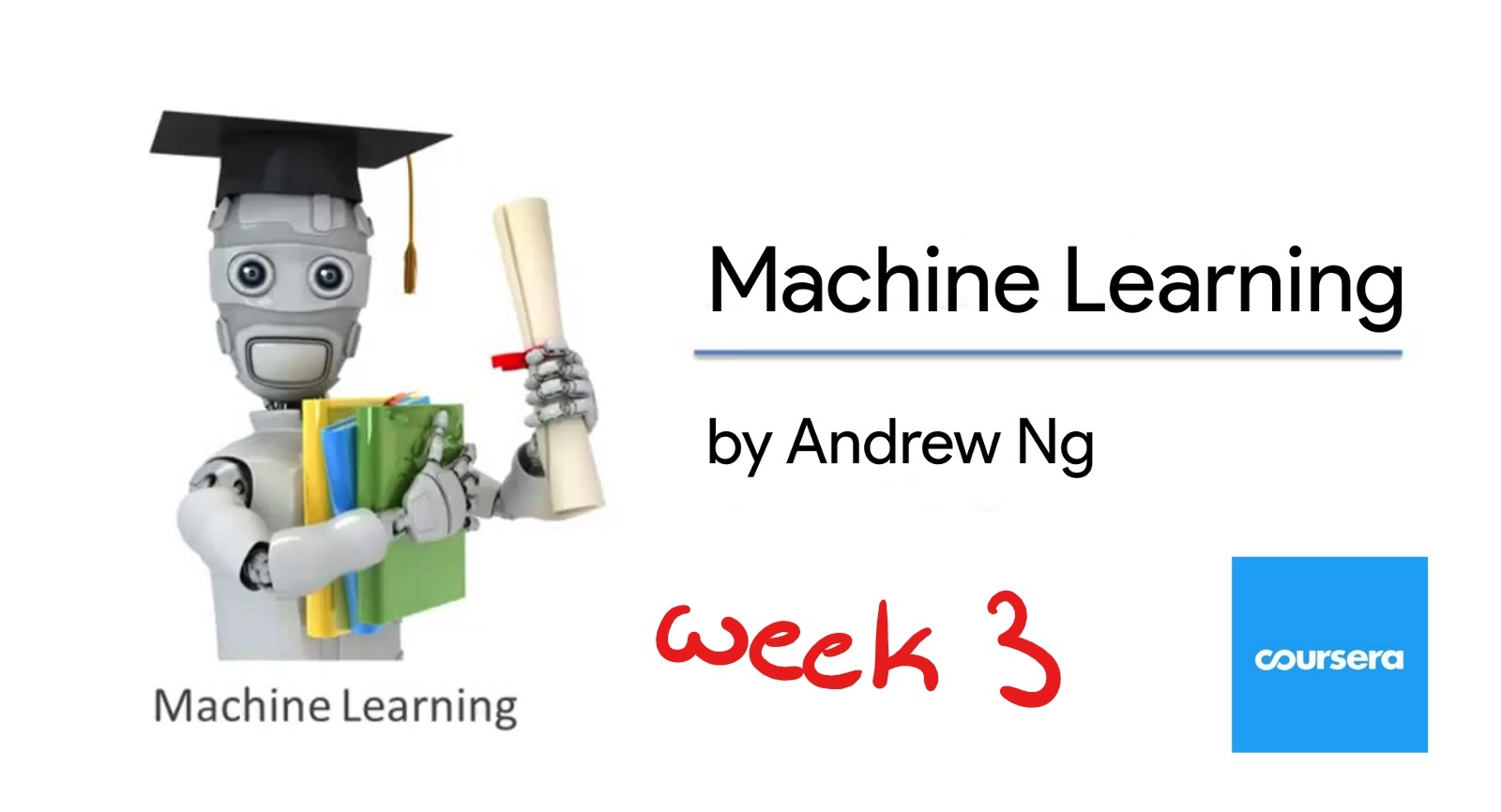
My notes from the Machine Learning Course provided by Andrew Ng on Coursera
Logistic Regression
Example of classification problem:
- Email: Spam/Not spam?
- Online transaction: Fraudulent (Yes/No)?
- Tumour: Malignant/Benign?
y \in \{0,1\} where
0 – "Negative class"
1 – "Positive class"
Multiclass classification problem y \in \{0,1,2,3,...\}
How to develop a classification algorithm?
Example of a training set for classification task:
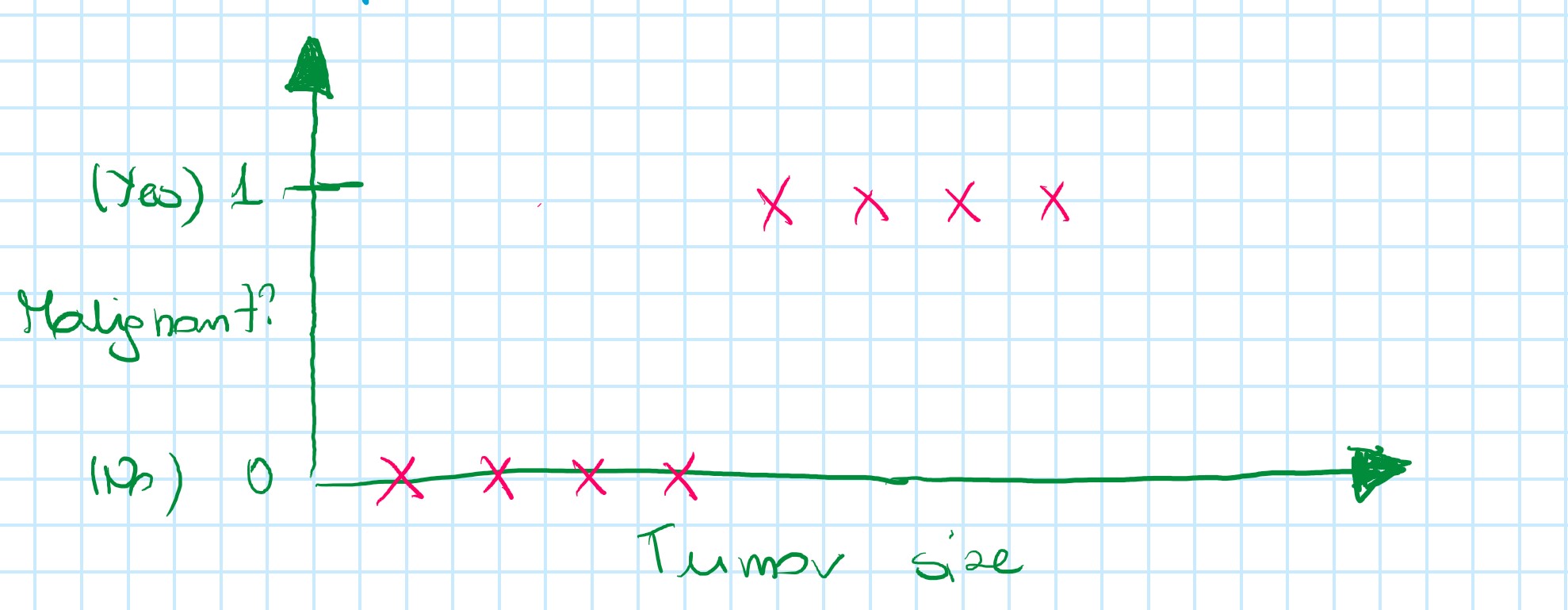
For this data set applying linear regression algorithm:
h_{\theta}(x)=\theta^Tx
and it could finish like below:

For prediction, it could be useful to try to do the threshold:
Threshold classifier output h_{\theta}(x) at 0.5: (vertical axis value)
- If
h_{\theta}(x) \geqslant 0.5, predict "y=1" - If
h_{\theta}(x) < 0.5, predict "y=0"
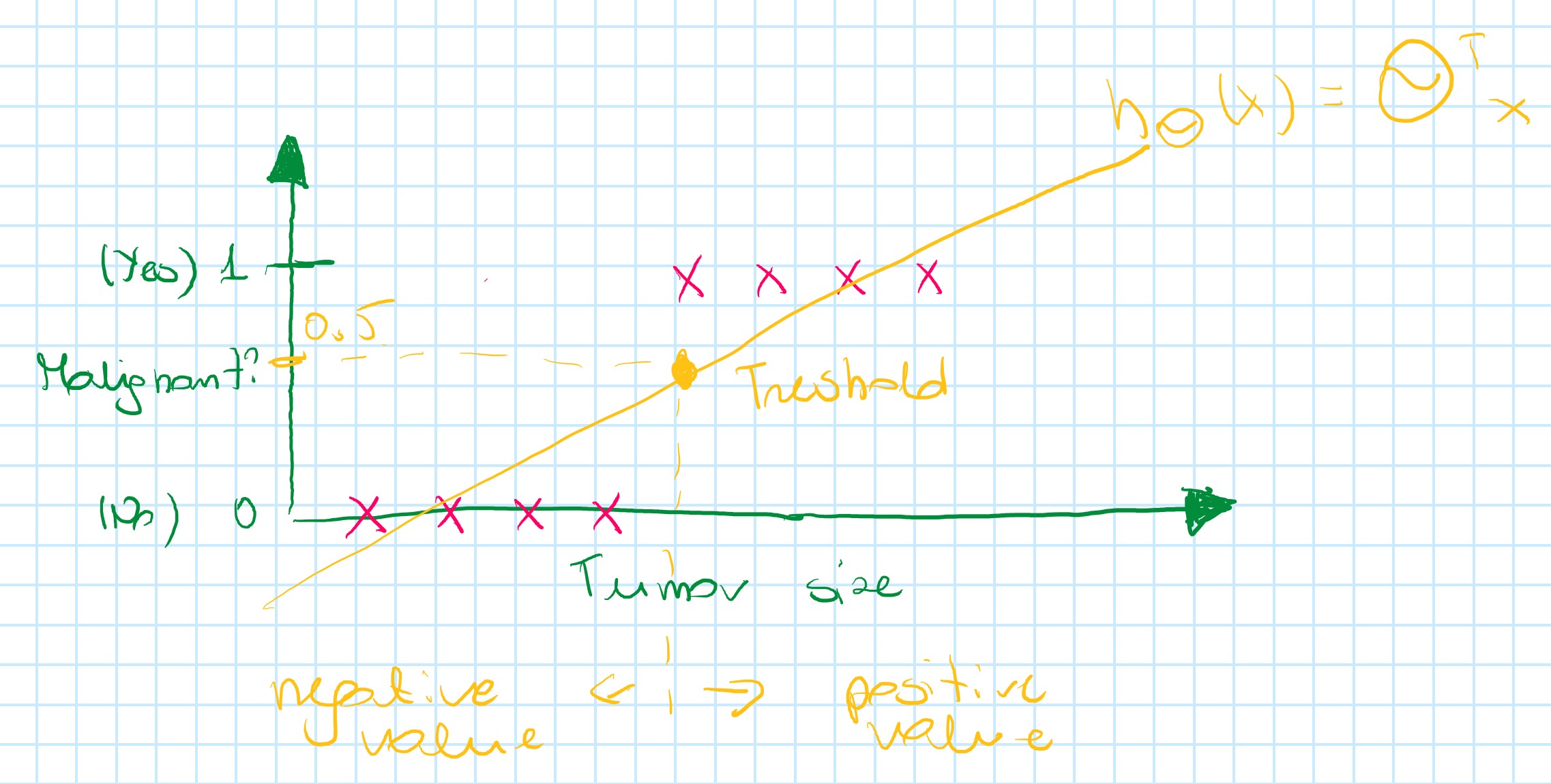
What happens if a problem will change a bit?
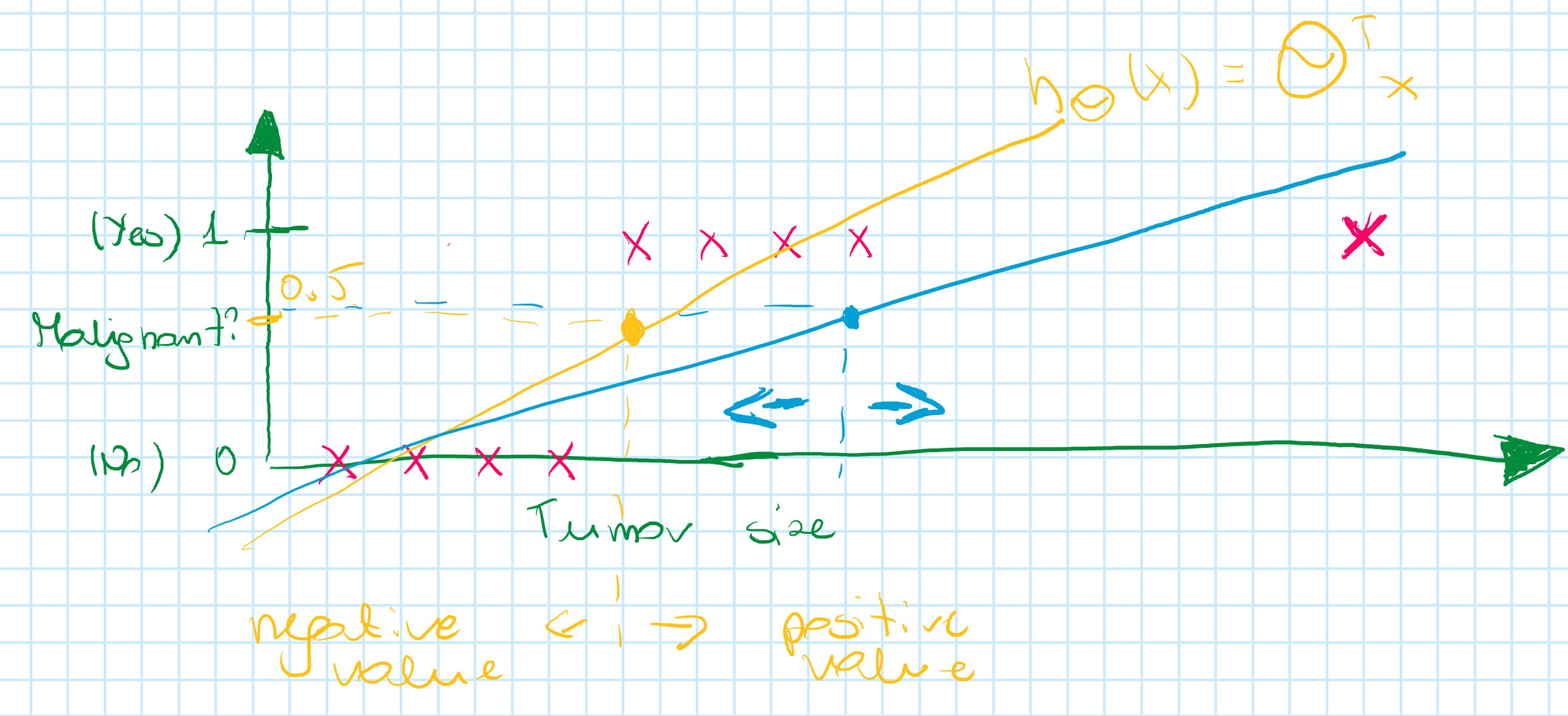
By adding one positive example cause linear regression to change, it's a straight line to fit the new data. It causes (in this example) a worse hypothesis.
Conclusion: Applying linear regression to classification problem often isn't a good idea
Funny bit of using linear regression on classification problem:
Classification: y=0 or y=1 but h_{\theta}(x) can be >1 or <0
So even when if we know that label should be 0 or 1, the linear regression could back with output values much larger than 1 or much smaller than 0.
Logistic Regression: 0 \leqslant h_{\theta}(x) \leqslant 1 - it's classification algorithm
Hypothesis Representation
Logistic Regression Model
Want 0 \leqslant h_{\theta}(x) \leqslant 1
h_{\theta}(x) = g(\theta^Tx)
g(z) = {1 \over {1 + e^{-z}}} (two different names for the same function: sigmoid function and logistic function )
\begin{rcases} h_{\theta}(x) = g(\theta^Tx) \\ g(z) = {1 \over {1 + e^{-z}}} \end{rcases}⇒h_{\theta}(x)={1 \over {1 + e^{-\theta^Tx}}}
z - real number
Sigmoid function
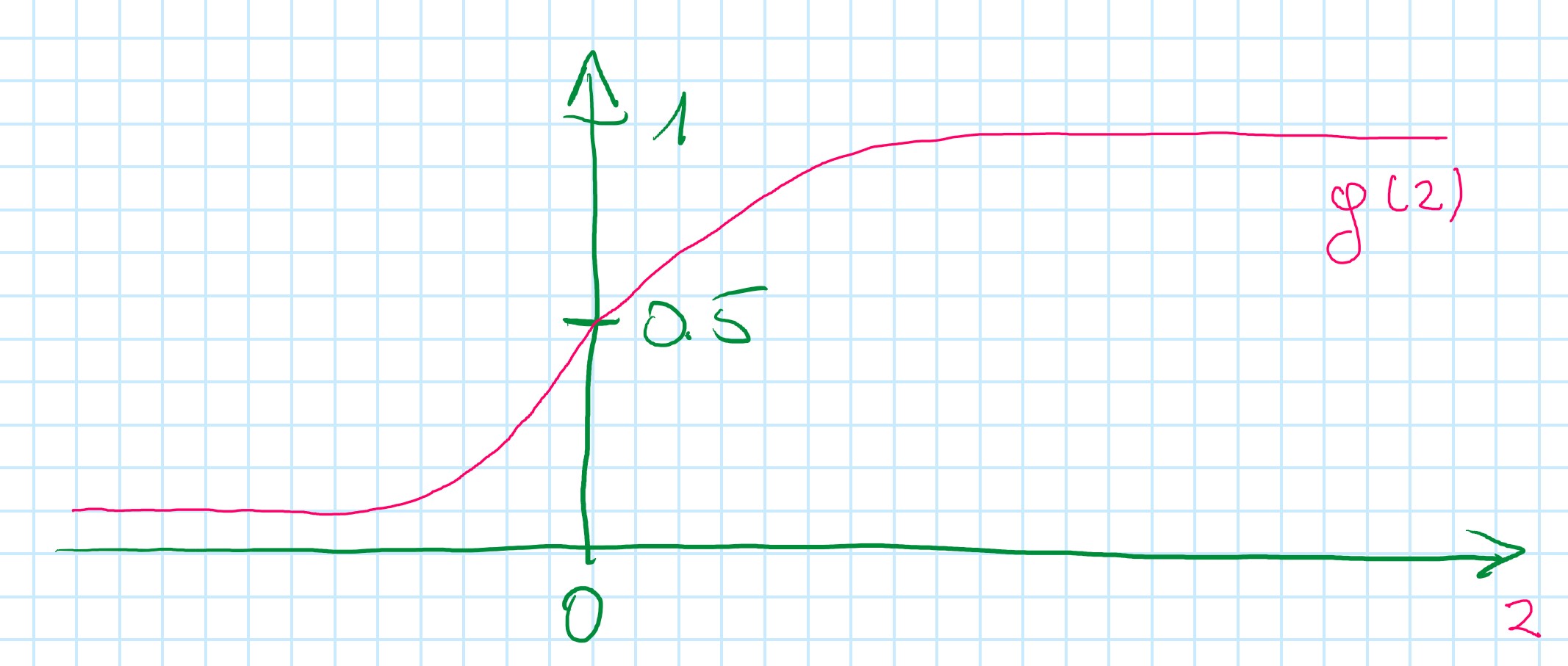
Parameters: \theta
Interpretation of Hypothesis Output
h_{\theta}(x) - estimated probability that y=1 on input x
Example:
\text{if } x = \begin{bmatrix} x_0 \\ x_1 \end{bmatrix} = \begin{bmatrix} 1 \\ \text{tumor size} \end{bmatrix}
h_{\theta}(x) = 0.7
Tell patient that 7-% chance of tumour being malignant
h_{\theta}(x) = P(y=1|x;\theta) - probability that y=1, give x, parameterized by \theta
Because this is a classification problem, then y can get only two values: 0 or 1
P(y=0|x;\theta) + P(y=1|x;\theta) = 1
P(y=0|x;\theta) = 1 - P(y=1|x;\theta)
Decision Boundary
Logistic Regression:
h_{\theta}(x) = g(\theta^Tx)
g(z) = {1 \over {1 + e^{-z}}}
Predict "y=1" if h_{\theta}(x) \geqslant 0.5
Predict "y=0" if h_{\theta}(x) < 0.5
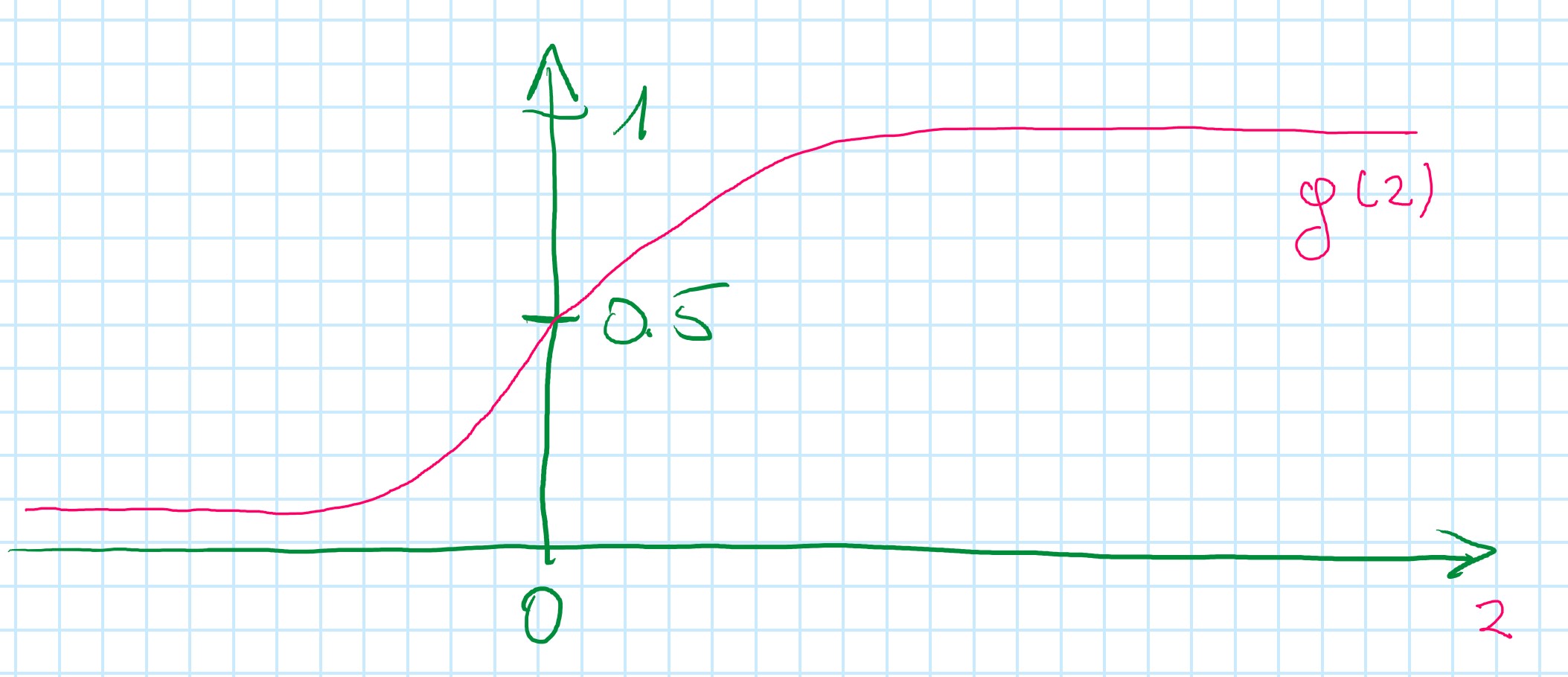
g(z) \geqslant 0.5 when z \geqslant 0
h_{\theta}(x) = g(\theta^Tx) \geqslant 0.5 where \theta^Tx \geqslant 0
Training set

h(_{\theta}(x) = q(\theta_0 + \theta_1x_1 + \theta_2x_2)
Based on the plot: h(_{\theta}(x) = q(-3 + 1x_1 + 1x_2)
so: \theta = \begin{bmatrix} -3 \\ 1 \\ 1 \end{bmatrix}
Predict: "y=1" if -3 + x_1 + x_2 \geqslant 0
-3 + x_1 + x_2 \geqslant 0
x_1 + x_2 \geqslant 3 - will create a straight line
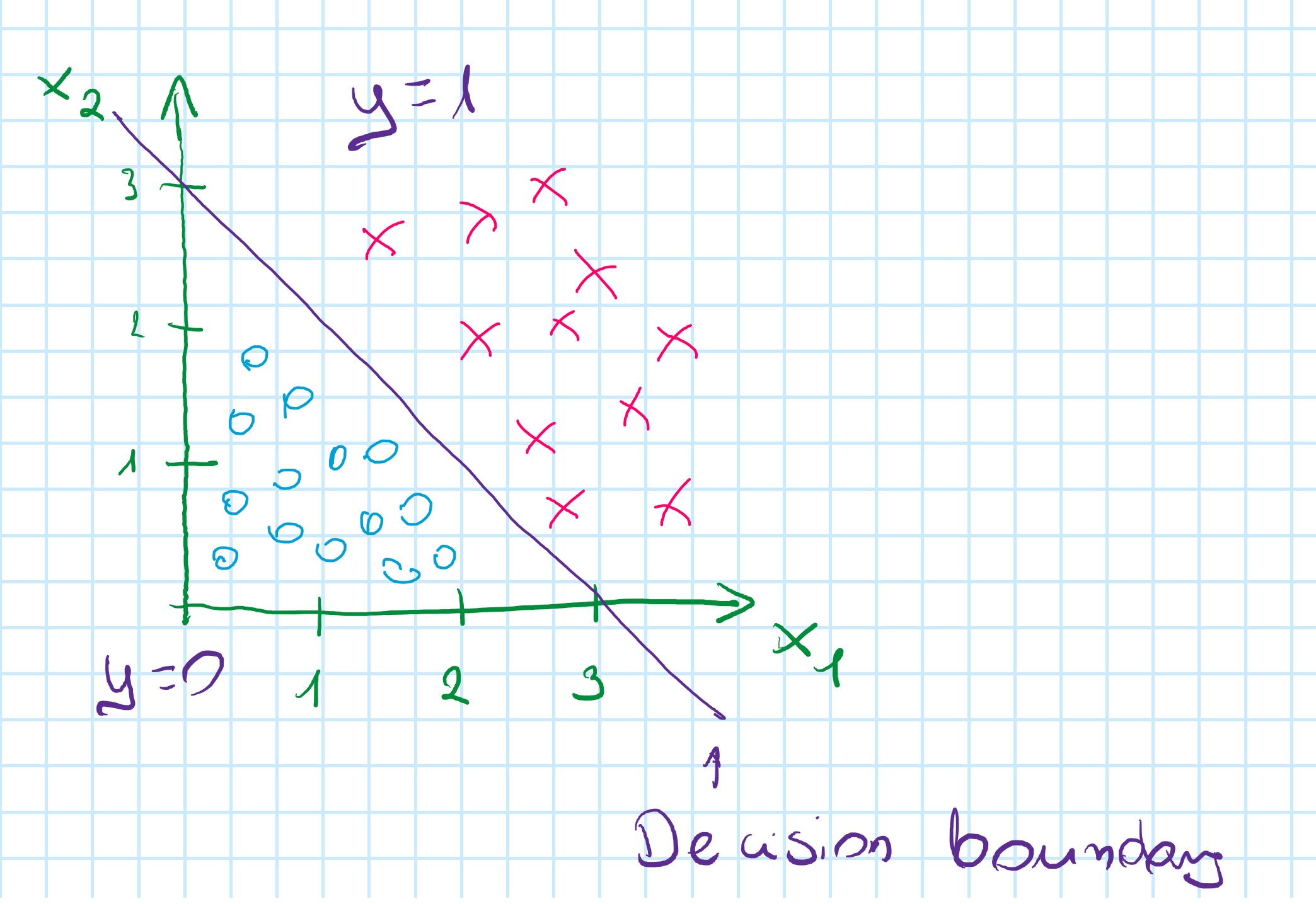
Exercise:
\theta_0=5; \theta_1=-1; \theta_2=0;
h_{\theta}(x) = g(5-x_1)
so: x_1 \geqslant 5
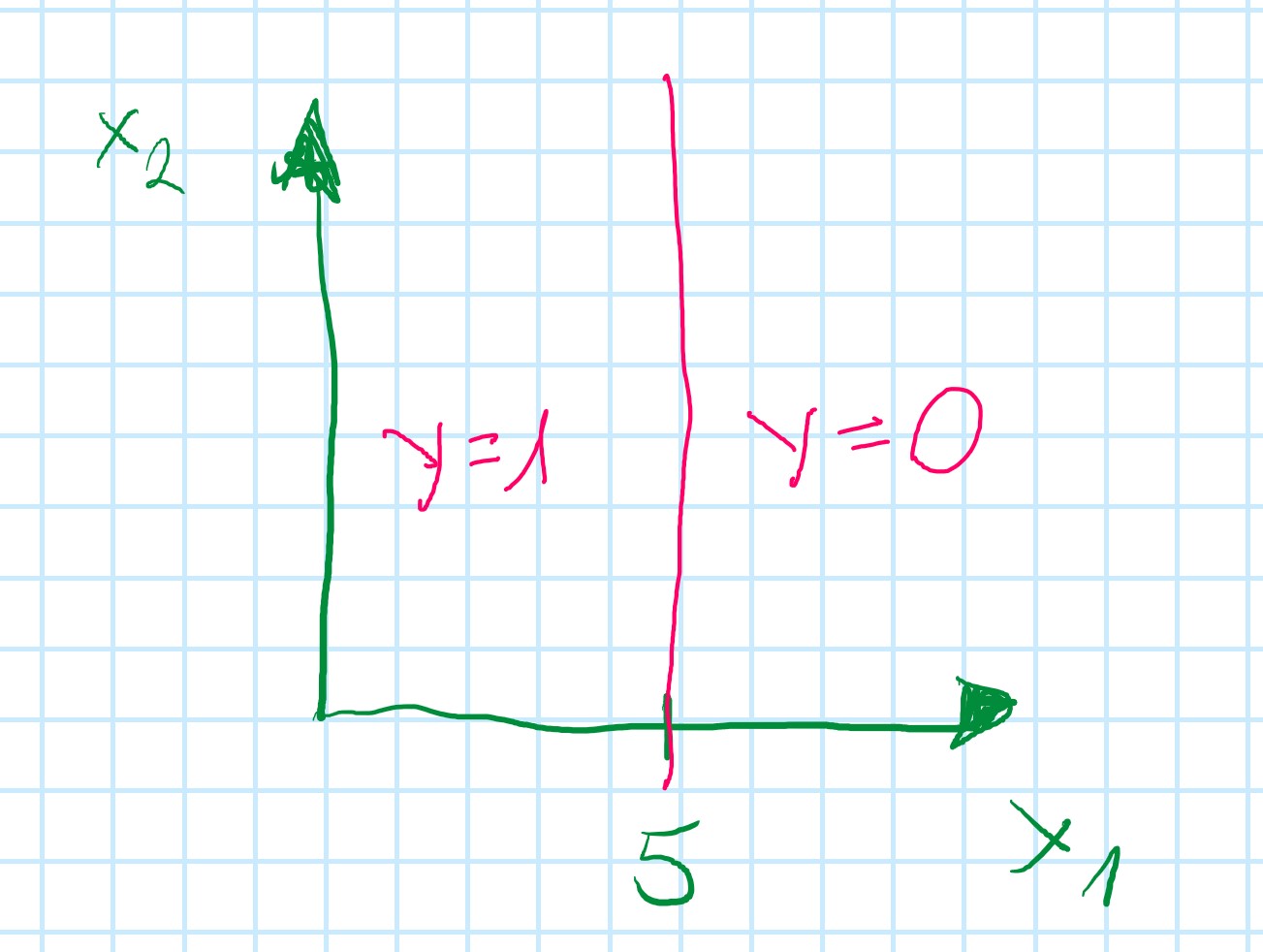
Non-linear decision boundaries
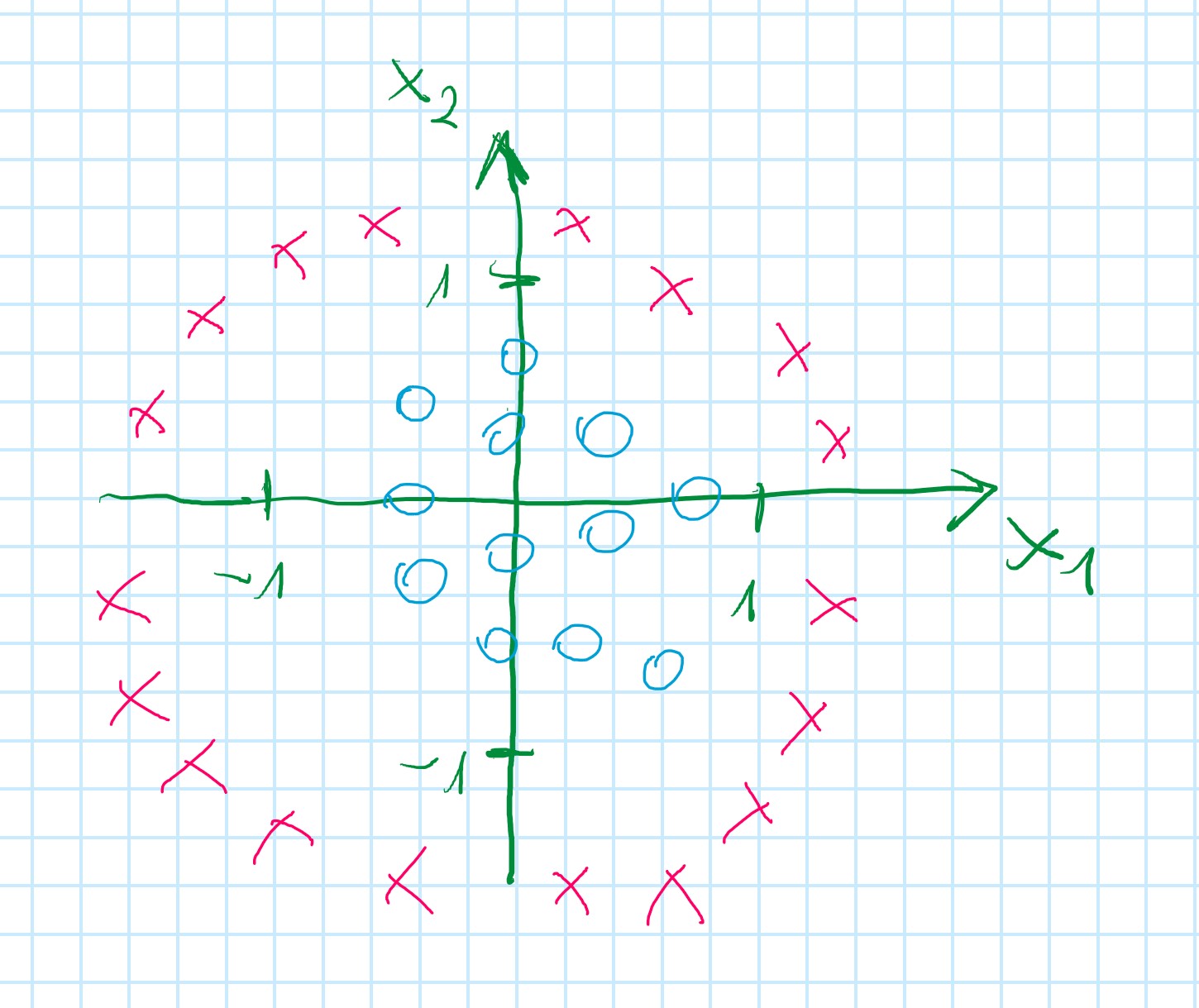
h_{\theta}(x) = g(\theta_0 +\theta_2x_2 + \theta_3x_1^2 + \theta_4x_2^2)
\theta = \begin{bmatrix} -1 \\ 0 \\ 0 \\ 1 \\ 1 \end{bmatrix}
Predict "y=1" if -1 + x_1^2 + x_2^2 \geqslant 0
x_1^2 + x_2^2 = 1
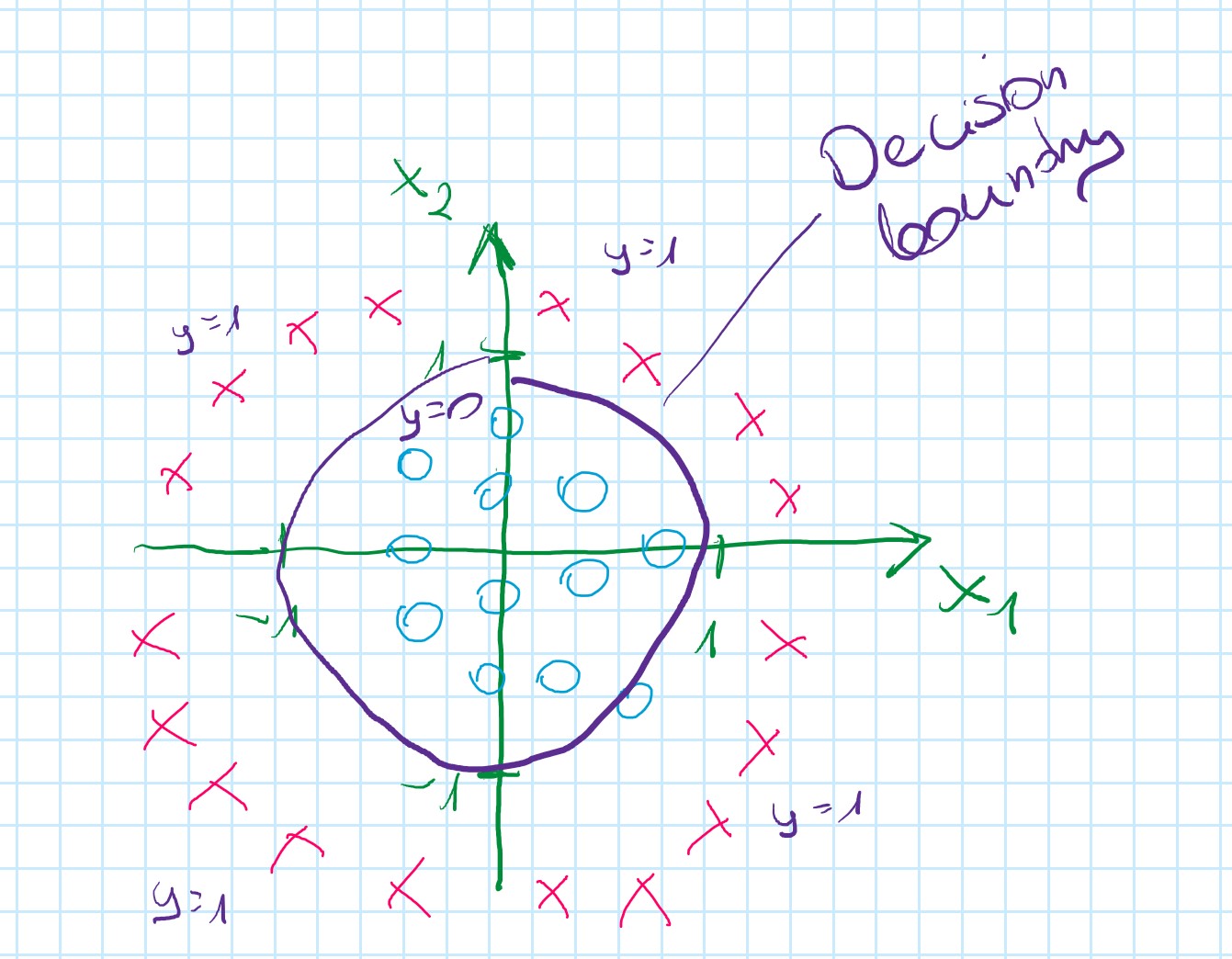
More complex decision boundaries
h_{\theta}(x) = g(\theta_0 +\theta_2x_2 + \theta_3x_1^2 + \theta_4x_2^2 + \theta_5x_1^2x_2^2 + \theta_6x_1^3x_2 + ...)
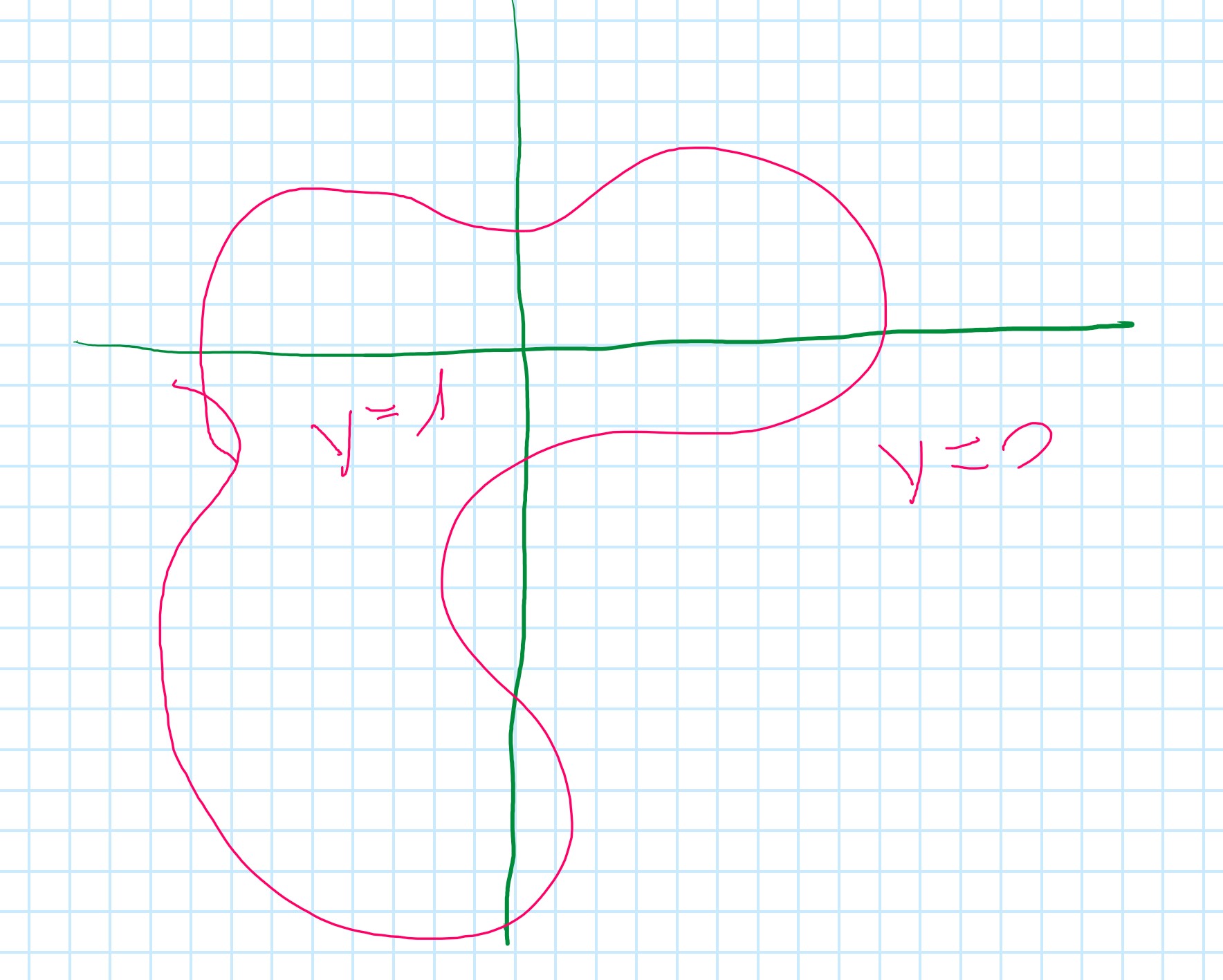
Cost Function
Supervised learning problem:
Training set: \{(x^{(1)}, y^{(1)}), (x^{(2)}, y^{(2)}), ... , (x^{(m)}, y^{(m)})\}
m examples:
x \in \begin{bmatrix} x_0 \\ x_1 \\ \vdots \\ x_n \end{bmatrix} x_0 =1, y \in \{0,1\}
h_{\theta}(x) = {1 \over 1 + e - \theta^Tx}
How to choose parameter \theta?
Cost function
Linear regression:
J(θ)=\frac{1}{m} \displaystyle\sum_{i=1}^m \frac{1}{2} (h_θ (x^{(i)})-y^{(i)})^2
An alternative way of writing this function:
J(θ)=\frac{1}{m} \displaystyle\sum_{i=1}^m cost (h_θ (x^{(i)}), y)
so:
Cost (h_θ (x^{(i)}), y) = \frac{1}{2} (h_θ (x^{(i)})-y^{(i)})
This function is fine for linear regression.
For logistic regression would also work fine, but as well would be a non-convex function of the parameters $\theta$
Example:
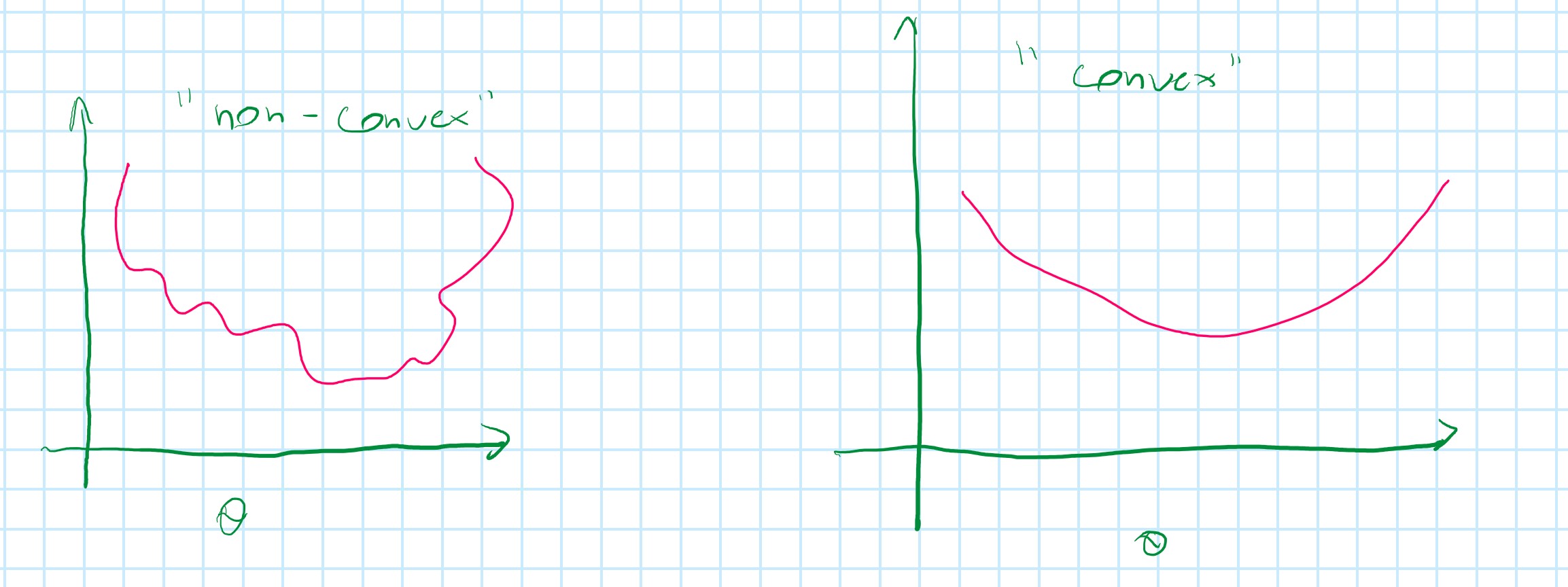
Logistic regression cost function
Cost (h_θ (x^{(i)}) = \begin{array}{cc} \log(h_{\theta}(x)) \text{if } y = 1 \\ \log(1 - h_{\theta}(x)) \text{if } y = 0 \end{array}
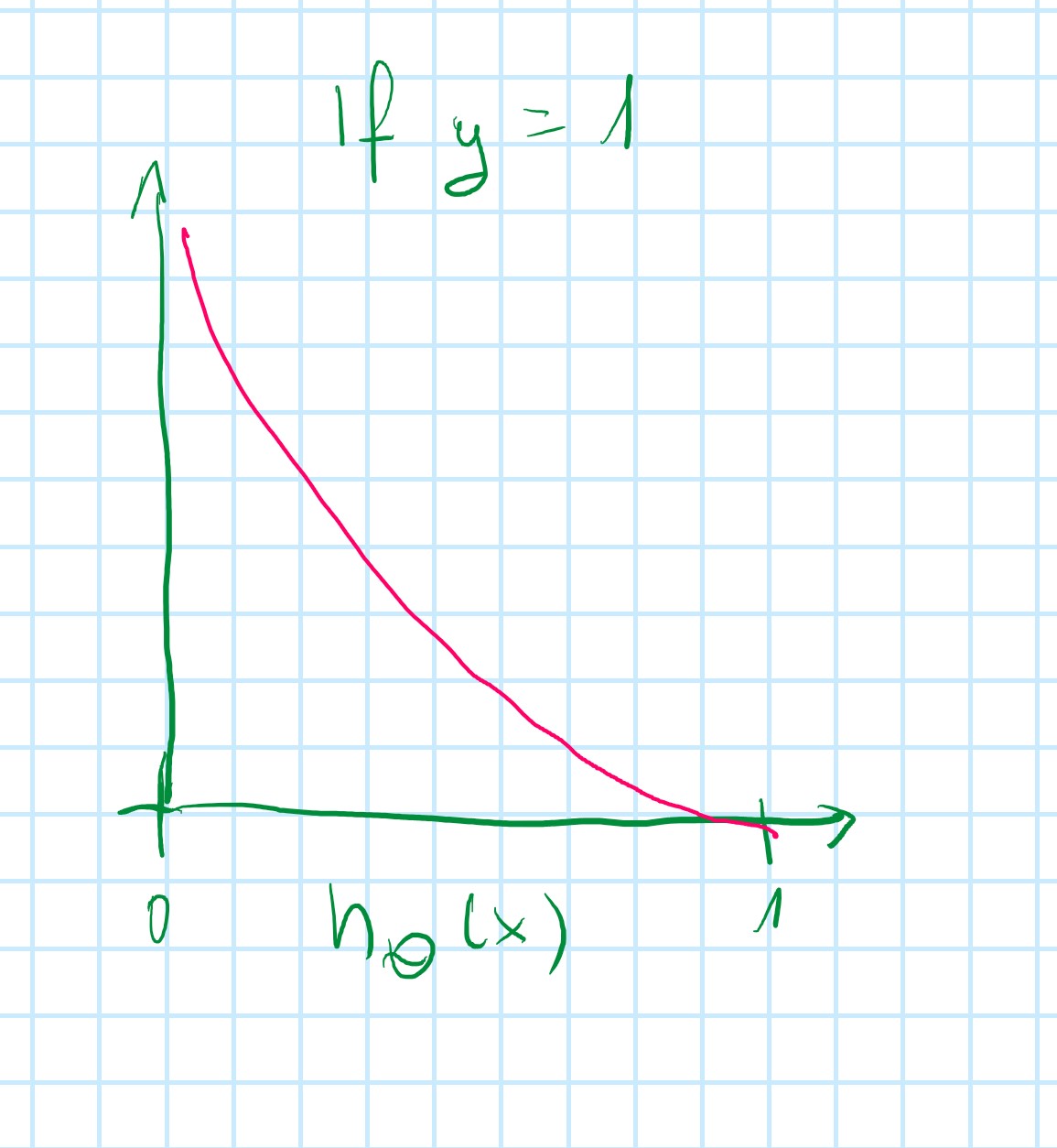
Cost = 0 if y = 1, h_{\theta}(x) = 1
But as h_{\theta}(x) \to 0 and Cost \to \infty
Capture intuition that if h_{\theta}(x) = 0 (predict P(y=1|x;\theta)=0), but y = 1, we will penalize learning algorithm by a very large cost
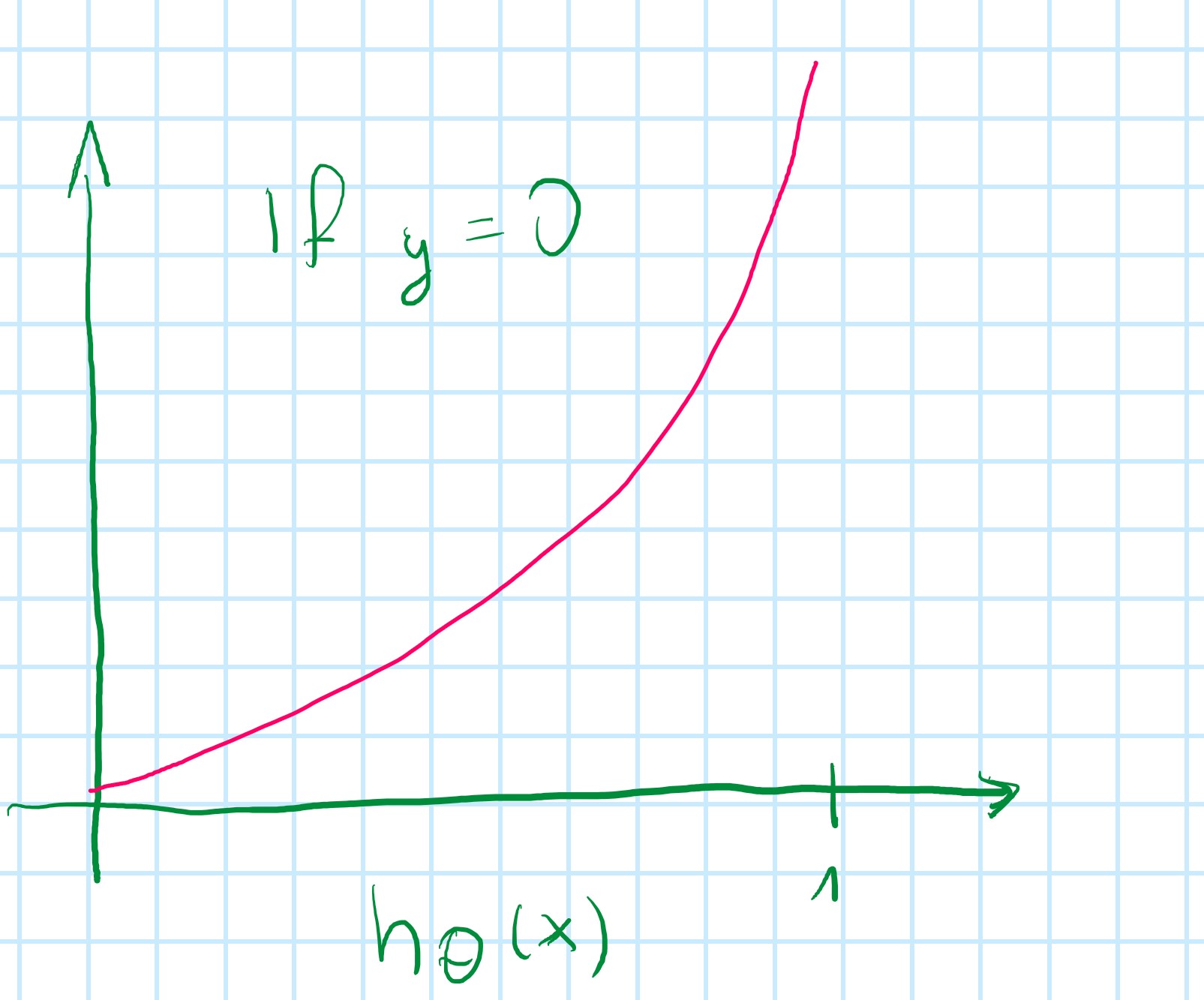
Simplified cost function and gradient descent
Logistic regression cost function
J(θ)=\frac{1}{m} \displaystyle\sum_{i=1}^m Cost (h_θ (x^{(i)}), y^{(i)})
Cost (h_θ (x^{(i)}) = \begin{array}{cc} \log(h_{\theta}(x)) \text{if } y = 1 \\ \log(1 - h_{\theta}(x)) \text{if } y = 0 \end{array}
Always y=0 \text{ or } y=1
Cost (h_θ (x),y) = -y\log(h_{\theta}(x)) - ((-y)\log(1-h_{\theta}(x)) (compact way to write in one line)
if y=1: Cost (h_θ (x),y) = -\log(h_{\theta}(x))
if y=0: Cost (h_θ (x),y) = -\log(1 - h_{\theta}(x))
Logistic regression cost function
J(θ)=\frac{1}{m} \displaystyle\sum_{i=1}^m Cost (h_θ (x^{(i)}), y^{(i)}) = -\frac{1}{m} \lbrack\displaystyle\sum_{i=1}^m y^{(i)} \log h_{\theta}(x^{(i)})+(1-y^{(i)})\log(1-h_{\theta}(x^{(i)})) \rbrack J(θ)=\frac{1}{m} \displaystyle\sum_{i=1}^m Cost (h_θ (x^{(i)}), y^{(i)})
To fit parameter \theta: \begin{matrix} min \\ \theta \end{matrix} J(\theta)
To make a prediction given new x:
Output h_{\theta}(x) = \frac{1}{1 + e^{-\theta T} x}
Gradient Descent
J(θ)=-\frac{1}{m} \lbrack\displaystyle\sum_{i=1}^m y^{(i)} \log h_{\theta}(x^{(i)})+(1-y^{(i)})\log(1-h_{\theta}(x^{(i)})) \rbrack
Want min_{\theta}J(\theta):
Repeat {
θ_j := θ_j - \alpha \frac{∂}{∂θ_j} J(θ)
}
(simultaneously update for every \theta_j)
\alpha \frac{∂}{∂θ_j} J(θ) = \frac{1}{m} \displaystyle\sum_{i=1}^m (h_θ (x^{(i)}) - y^{(i)})x_j^{(i)}
so:
Repeat {
θ_j := θ_j - \alpha \displaystyle\sum_{i=1}^m (h_θ (x^{(i)}) - y^{(i)})x_j^{(i)}
}
(simultaneously update all \theta_j)
\theta = \begin{bmatrix} \theta_0 \\ \theta_1 \\ \theta_2 \\ \vdots \\ \theta_n \end{bmatrix} h_{\theta}(x)=\frac{1}{1 + e^{\theta^Tx}}
Algorithms look identical like linear regression but have a different h_{\theta}(x) definition.
Advanced Optimalisation
Optimalisation algotithms
Cost function J(\theta). Want min_{\theta}J(\theta).
Given \theta, we already have a code that can compute:
J(\theta)-
\frac{∂}{∂θ_j} J(θ)(forj=0,1,...,n)Gradient descent
Repeat {
θ_j := θ_j - \alpha \frac{∂}{∂θ_j} J(θ)
}
Other (than Gradient descent) optimasation algorithms:
- Conjugate gradient
- BFGS
-
L-BFGS
Advantages of using those algorithms:
- No need to manually peek
\alpha- have inline search algorithm that automatically tries different values for the learning rate
\alpha, and automatically picks a good learning rate\alpha - Often faster than gradient descent
- have inline search algorithm that automatically tries different values for the learning rate
Disadvantages of using those algorithms:
- More complex and advanced
Example:
\theta = \begin{bmatrix} \theta_1 \\ \theta_2 \end{bmatrix}
\begin{matrix} min \\ \theta \end{matrix} J(\theta) \implies \theta_1=5; \theta_2=5
J(\theta) = (\theta_1 - 5)^2 + (\theta_2 - 5)^2 (cost function)
\frac{∂}{∂θ_1}J(\theta) = 2(\theta_1-5)
\frac{∂}{∂θ_2}J(\theta) = 2(\theta_2-5)
Prove in Octave:
>> options = optimset('GradObj', 'On', 'MaxIter', 100);
>> initialTheta = zeros(2,1);
>> function [jVal, gradient] = costFunction(theta)
jVal = (theta(1)-5)^2 + (theta(2)-5)^2;
gradient = zeros(2,1);
gradient(1) = 2*(theta(1)-5);
gradient(2) = 2*(theta(2)-5);
endfunction
>> [optTheta, functionValm exitFlag] = fminunc(@costFunction, initialTheta, options)
optTheta =
5.0000
5.0000
functionValm = 1.5777e-30
exitFlag = 1fminunc - Advance Optimalization function in Octave
Multi-class classification: ONE-VS-ALL
Multiclass classification
Examples:
- Email foldering/tagging: Work
(y=1), Friends(y=2), Family(y=3), Hobby(y=4) - Medical diagrams: Not ill
(y=1), Cold(y=2), Flu(y=3) - Weather: Sunny
(y=1), Cloudy(y=2), Rain(y=3), Snow(y=4)
Binary classification
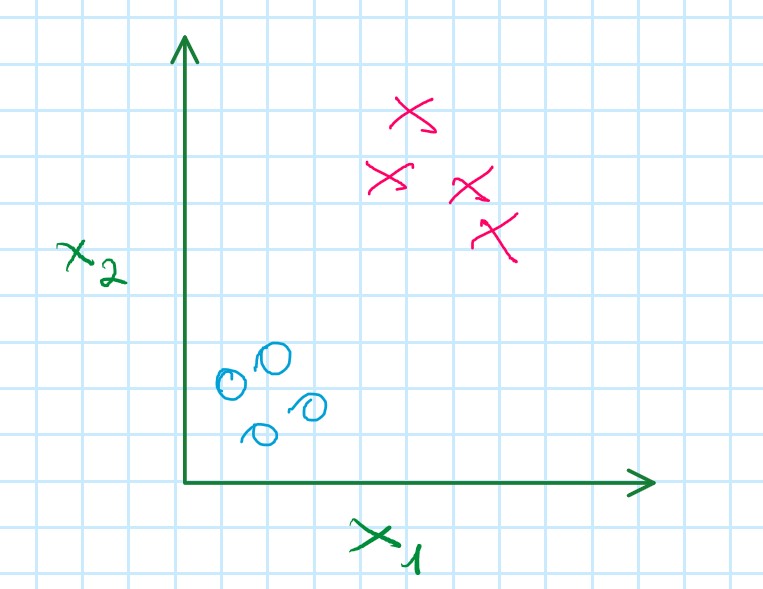
Multi-class classification
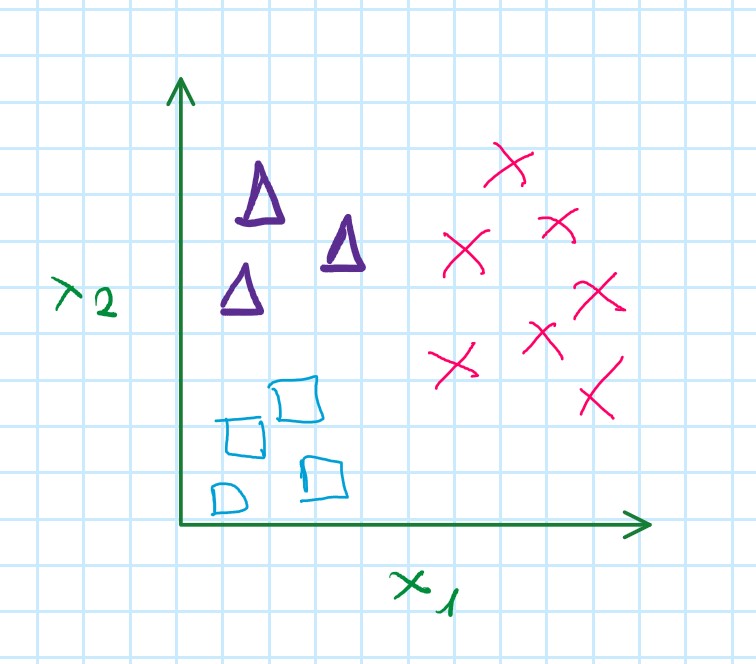
Question: How do we get a learning algorithm to work for the setting?
One-vs-all (one-vs-rest)
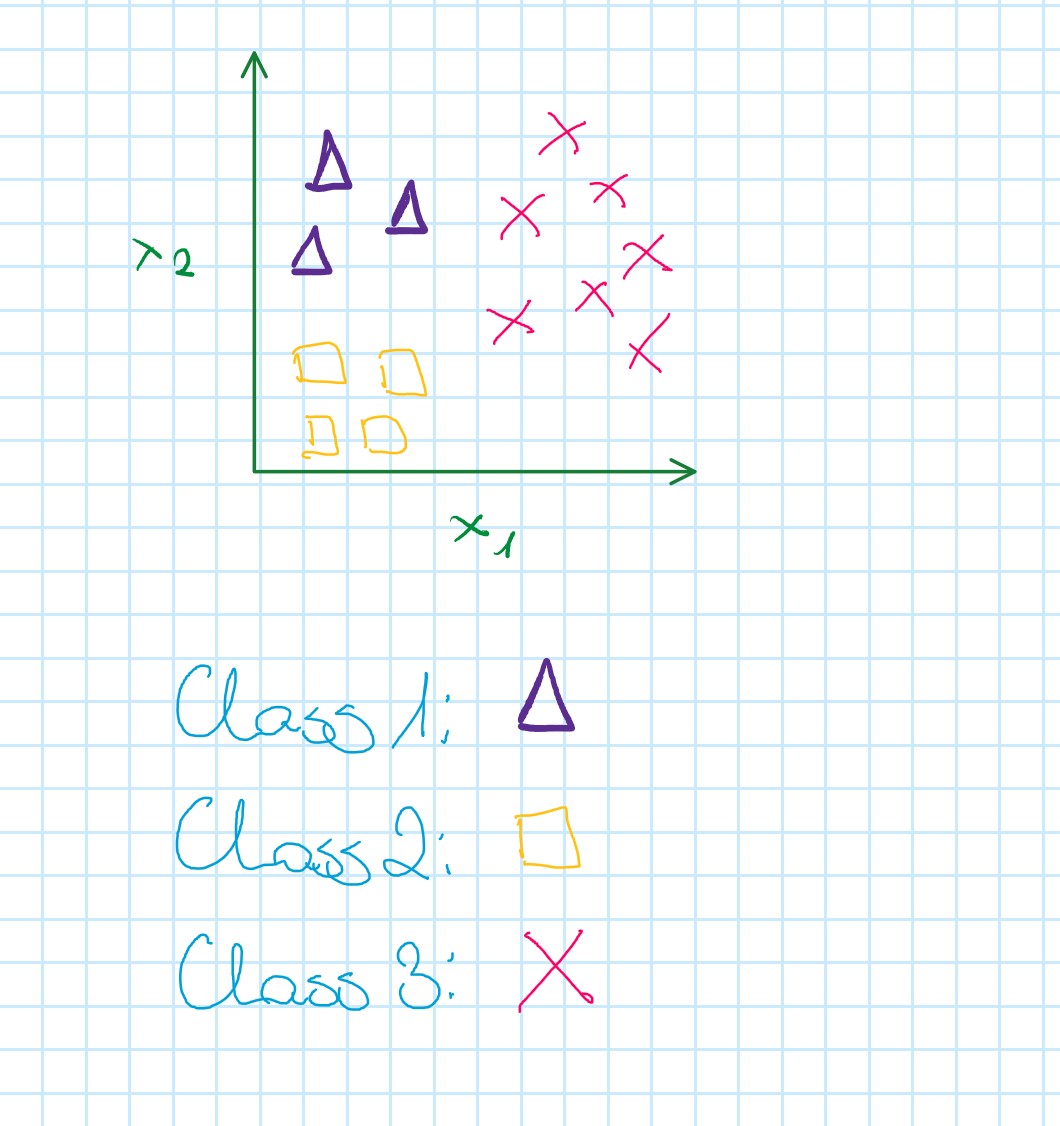
Step 1: Creating a new training set to fit the classifier h_{\theta}^{(1)}(x)
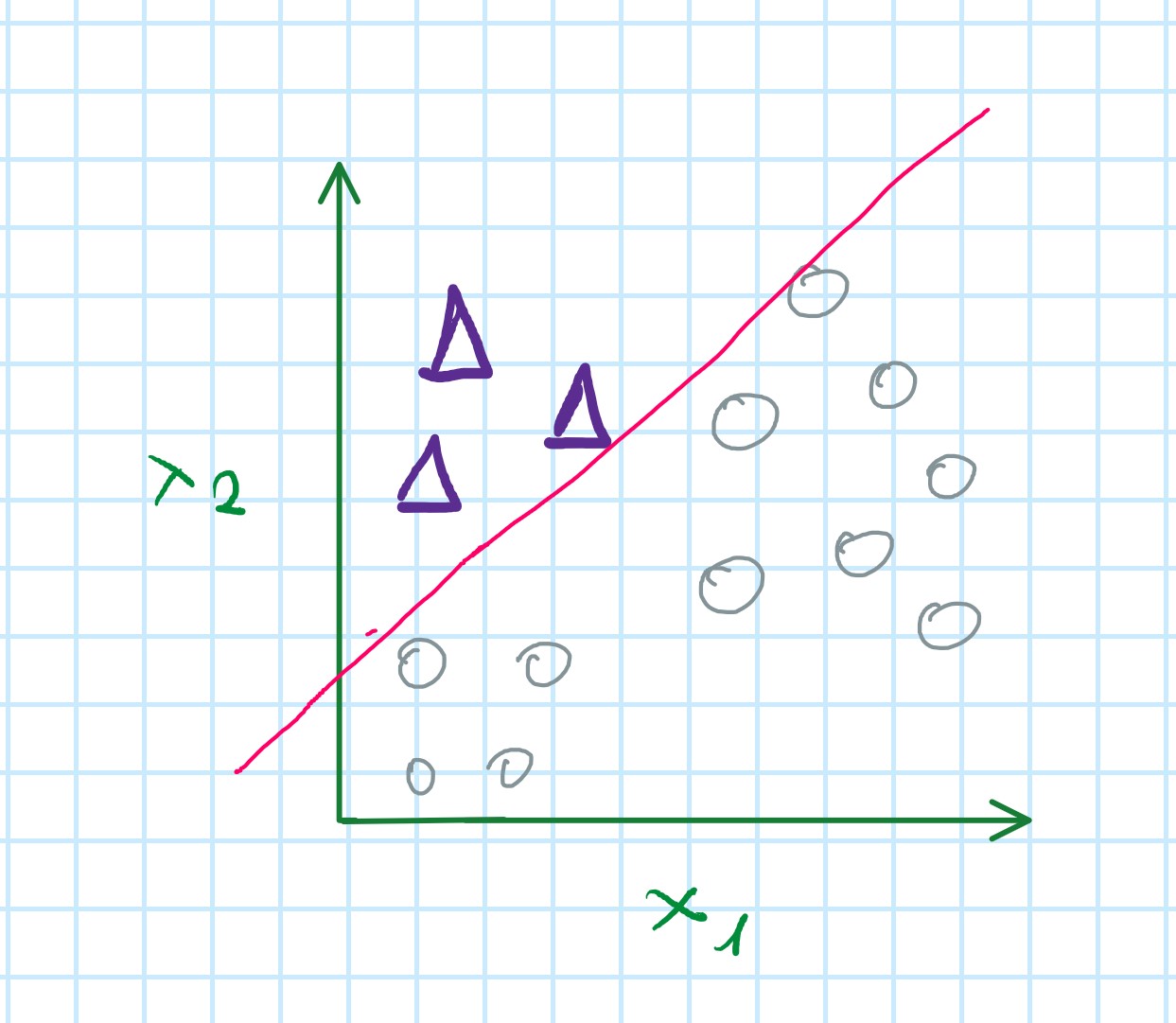
Step 2: Creating a new training set to fit the classifier h_{\theta}^{(2)}(x)
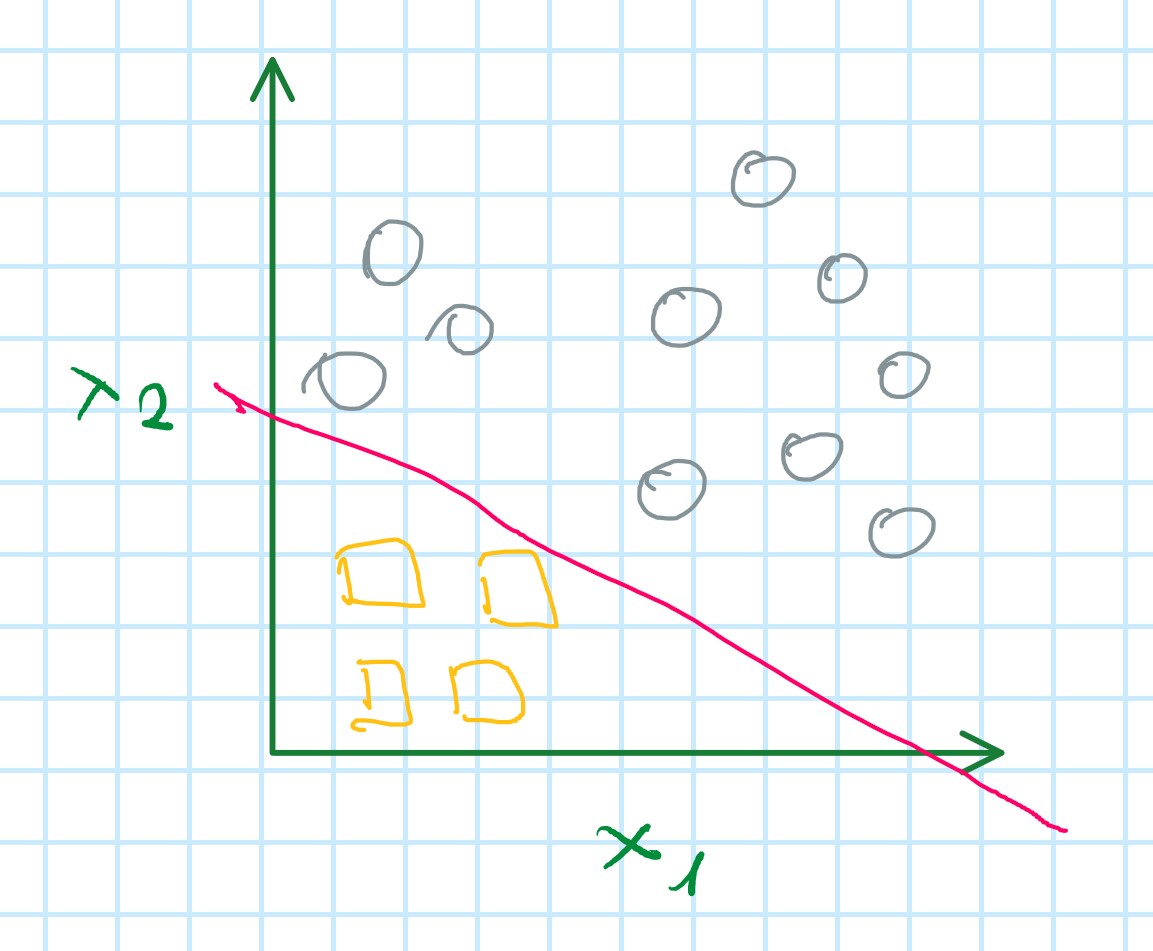
Step 3: Creating a new training set to fit the classifier h_{\theta}^{(3)}(x)
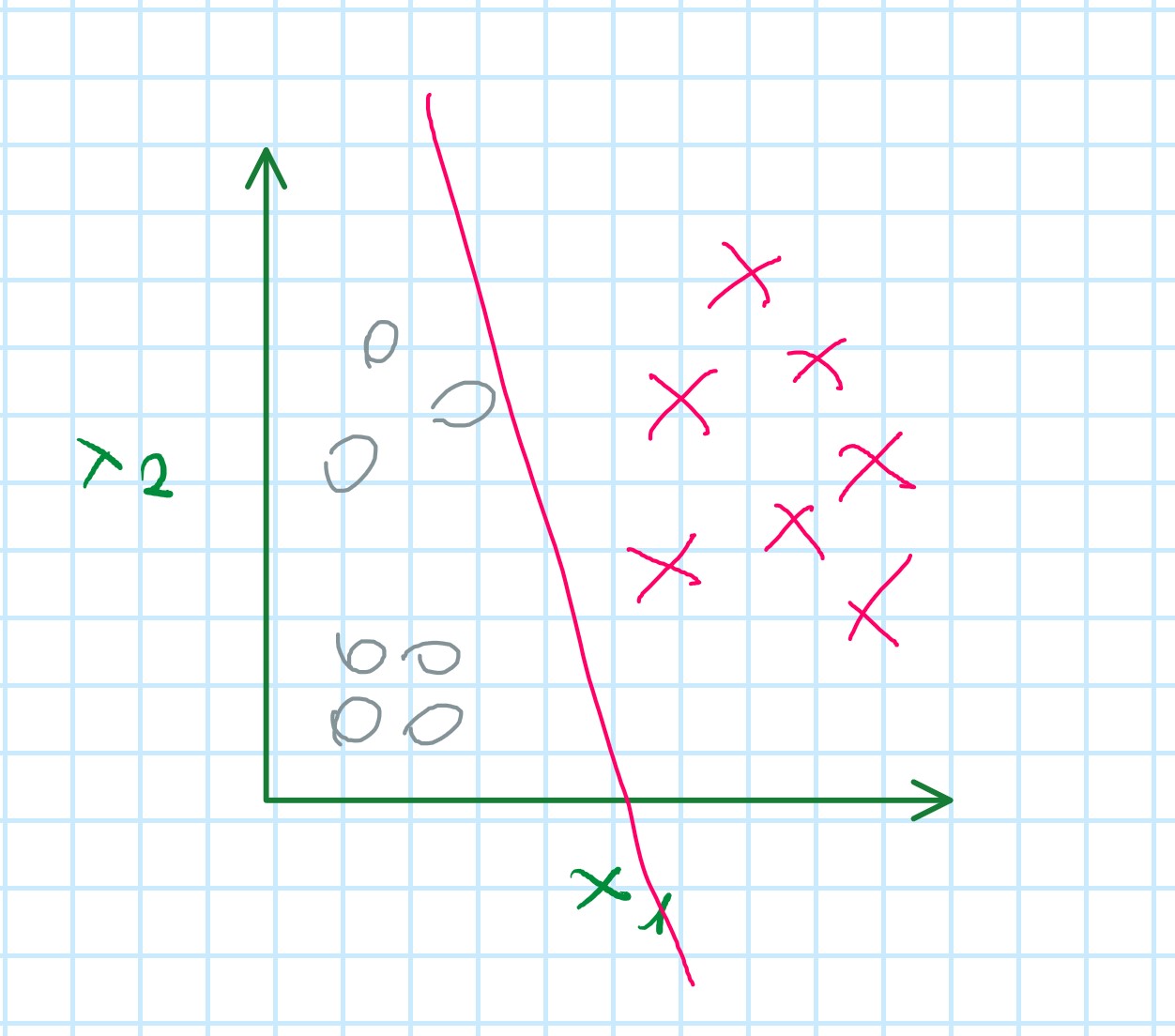
We fit three classifiers what is a probablity of one of the three classes:
h_{\theta}^{(i)}(x) = P(y=i|x;\theta)
One-vs-all
Train a logistic regression classifier h_{\theta}^{(i)}(x) for each class i to predict the probability that y=i
On a new input x, to make a prediction, pick the class i ythat maximaizes: \begin{matrix} max\\ i \end{matrix} h_{\theta}^{(i)}(x)
